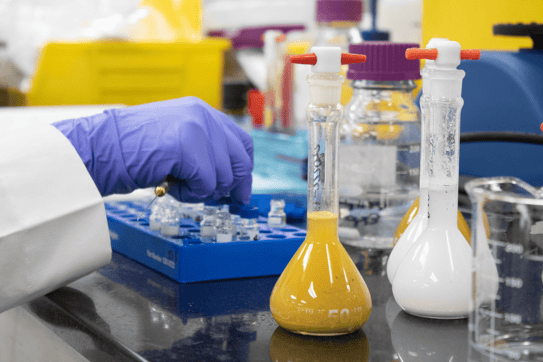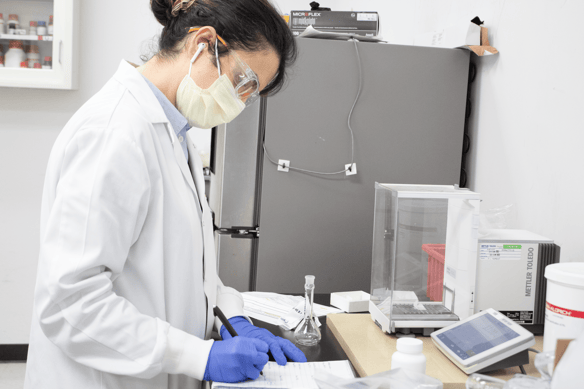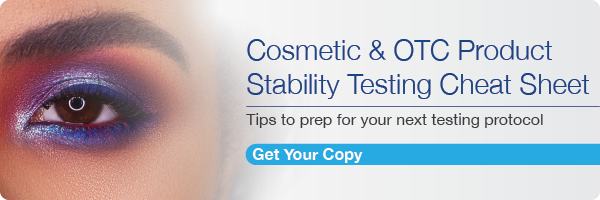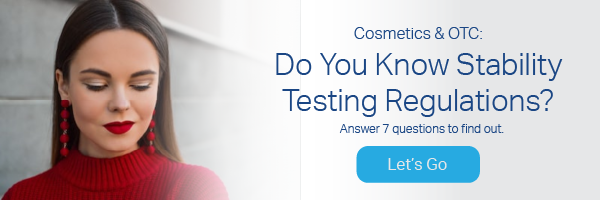Stability testing is the process of evaluating a product to ensure that key attributes stay within acceptable specifications during the aging process. Physical test parameters include appearance, color, odor, viscosity, pH, and package compatibility as analyzed using microbiological and/or analytical testing.
It’s an effective way to determine the shelf-life, expiration date, and overall long-term performance of a range of products, including cosmetics, over-the-counter (OTC), personal care products, dietary supplements, and medical devices.
In this post, we’ll focus on cosmetic stability testing, which includes personal care products, and OTC stability tests.
What are the Regulations for OTC and Cosmetic Stability Testing?
The regulatory environment for stability testing for cosmetics, personal care products, and over-the-counter (OTC) products is nuanced, with distinct guidelines for each category:
OTC Stability Testing Regulations
- The FDA mandates expiration dates on OTC-drug product labels per 21 CFR 211.137, unless exempt under 21 CFR 211.137(g).
- Some OTC products, like sunscreen products, acne treatments, and antiperspirants, are regulated as drugs. Such products must undergo stability testing as per 21 CFR 211 and display expiration dates on their labels.
Cosmetic Stability Testing Regulations
- U.S. laws do not mandate cosmetics to have a specified shelf-life or expiration date on their labels.
- The safety of the cosmetic product, including shelf-life, is considered the manufacturer’s responsibility.
- The FDA recommends using third-party laboratories for stability testing to maintain objectivity and manage the high costs associated with maintaining a stability program.
Key Reasons for Cosmetic Stability Testing
Although not mandated under U.S. law, many cosmetic manufacturers perform stability testing on their products nonetheless for a few important reasons:
- Ensure products don't become unsafe during their shelf-life, including tests for microbial contamination.
- Ensure the product maintains its intended benefits and characteristics, such as texture, color, and odor, throughout its shelf-life.
- Determining expiration dates through stability testing can help reduce the wasteful disposal of effective and safe products.
Distinguishing Between Cosmetics and OTC-Drugs
The FDA's approach to classifying a product as a cosmetic or a drug is based on claims, intended use, and sometimes formulation.
By law, cosmetics may only cleanse, beautify, promote attractiveness, or alter appearance.
In contrast, any product claiming to affect the structure or function of the body is considered a drug.
This regulatory distinction between cosmetics and drugs is crucial as it determines the subsequent regulatory requirements, including allowable ingredients, testing, and labeling.
Does MoCRA Affect Stability Testing for Cosmetics?
Historically, cosmetics have had minimal FDA regulatory requirements, focusing mainly on marketing claims and intended use.
The Modernization of Cosmetics Reform Act (MoCRA) brings significant changes, aligning many cosmetic product requirements with those applicable to OTC-drugs, including mandatory Good Manufacturing Practices (GMPs), product registration, safety substantiation, and more.
An important aspect of product safety and quality assessments is testing for product degradation or stability. While MoCRA doesn’t explicitly require stability testing for cosmetics, many companies conduct these stability studies to determine appropriate cosmetic expiration dates when they might be required to ensure safety.
 A cosmetic stability test will typically include analyzing the product at various time points for chemical/physical changes and microbiological contamination.
A cosmetic stability test will typically include analyzing the product at various time points for chemical/physical changes and microbiological contamination.
What Tests are Performed During OTC Stability Testing or a Cosmetics Stability Study?
Stability protocols are designed to evaluate the stability of the product over time under different environmental conditions, such as temperature, humidity, and light exposure. There are essentially three types of tests that will be performed to evaluate the product during the stability study:
Microbiological Tests
Microbial contamination can occur during manufacturing or after the product has been opened by the customer. They potentially introduce microbes each time they use the product.
This presents the opportunity for mold, yeast, or bacteria to contaminate the product and potentially cause an adverse reaction. Microbiological testing helps determine the effectiveness of the product's preservative system, known as preservative efficacy testing (PET).
At various time points throughout a stability testing protocol, microbiologists will perform quantitative analysis to determine the count levels of mold, yeast, or bacteria in the product. Quantitative analysis is superior to a simple screening test, which can only tell you if microbes are present, but not actual colony counts.
Chemical/Physical Tests
This type of testing evaluates how the cosmetic, personal care product, or OTC product reacts to stressors like temperature extremes, humidity, and light. It can evaluate the following characteristics:
- Color
- Odor
- pH
- Viscosity
- Appearance
- Package compatibility
- Specific gravity
The product is placed in a sealed chamber set to a specific temperature and humidity range. Many manufacturers test their products at elevated temperatures (e.g. 45°C/75% RH) for a specified time to provide a trend from which they can extrapolate its performance at room temperature over a longer period of time. This helps save time during R&D.
The product is pulled from the chamber at prescribed time points for analysis, then returned for continued testing until reaching the end of the time period (e.g. six months, 12 months, 5 years).
Humidity levels also play an important role. Imagine a customer purchasing your product and storing it in a bathroom its entire life exposed to extreme swings in humidity. You want to ensure your product can withstand that type of environment throughout its shelf life.
Stability Testing & ICH Guidelines
Labs use various conditions during stability testing to evaluate the product's performance, with the intent of challenging the product with the conditions most likely to be encountered once the product leaves the facility.
Certified Laboratories follows International Conference of Harmonization (ICH) guidelines and performs stability testing under the following conditions:
- 25°C/60% RH
- 40°C/75% RH
- 30°C/65% RH
- 30°C/75% RH
- 45°C
- 50°C
- 60°C
- 5°C (Refrigerator)
- UV
- Photostability [per ICH Q1B guidelines, option 2 (1.2 million lux – hour/ 200 W/M²)]
- Freeze/thaw (-10°C to -20°C)
- Ambient/Above Ambient (25°C/60% RH ± 5% RH, then moved to 45°C for 3 cycles)
- PAO (Period After Opening) determination
Stability Testing of Packaging (Compatibility Test)
The packaging of a product plays a critical role in determining its shelf-life and overall stability. Chemical reactions between the product and its packaging can compromise performance. Additionally, packaging that isn't airtight may allow air or moisture to infiltrate, leading to product degradation.
To ensure product safety and quality, stability testing evaluates these potential interactions. Known as a "compatibility test," this process assesses how well the product and its packaging work together over time. It determines whether any adverse reactions occur, such as leaking, discoloration, or exposure to air, all of which can affect the product's quality or safety.
For the most accurate results, it's recommended to conduct stability testing using the product’s final packaging. This helps identify any potential issues and ensures the product remains effective and safe throughout its intended shelf life.
When Should I Perform OTC Stability Testing or Cosmetic Stability Testing?
You can run a cosmetic or OTC stability test whenever your company needs product data, but best practices dictate performing a stability test when any of the following occur:
- Development of a new product.
- Reformulation of an existing product.
- Change in production methods, facilities, packaging, or vendors.
-min.png?width=575&height=383&name=BUR_Stability_1687%20(1)-min.png)
Stability testing is performed using calibrated storage chambers set to prescribed temperature and humidity settings.
What are the Steps for an OTC Stability Test or Cosmetic Stability Test?
Specific procedures for OTC or cosmetic shelf-life and stability testing vary depending on the product type, raw materials, and other factors. Be sure to follow the appropriate stability testing methods for OTC products or cosmetics, and to consult with a qualified professional to ensure that testing is conducted accurately and thoroughly.
That said, stability testing for OTC, cosmetic, and personal care products generally follows these steps:
Produce the Batch
International Conference on Harmonization (ICH) guidelines say that data from formal stability studies should be provided on at least three primary batches of the product. The batches should be manufactured to a minimum of pilot scale using the same manufacturing methods and procedures as production batches.
Fill Test Containers
ICH guidelines recommend performing a stability study on the product packaged in a container that is the same or that simulates the containers that will be used during distribution and storage.
It is best practice to test the finished product as it will be marketed to gather data on how the packaging and product itself interact during storage.
Conduct Initial Tests at Time Point Zero
Test the attributes of your product that are susceptible to change and that are likely to influence quality and safety. Testing should include the appropriate microbiological, chemical/physical, and packaging tests needed for your product.
At minimum, test appearance, odor, pH, and viscosity.
These readings take place at the initial time point and provide a baseline against which to compare results from future time points.
Store the Product in a Stability Chamber
Next, store the product in a controlled, calibrated stability chamber set to the appropriate temperature and humidity. Exact settings will vary depending on the product and expected storage conditions, but ICH provides the following guidelines:
|
Study |
Storage condition |
Minimum time period covered |
|
Long-term* |
25°C ± 2°C/60% RH ± 5% RH Or 30°C ± 2°C/65% RH ± 5% RH |
12 months |
|
Intermediate** |
30°C ± 2°C/65% RH ± 5% RH |
6 months |
|
Accelerated |
40°C ± 2°C/75% RH ± 5% RH |
6 months |
* It is up to you to decide whether long-term stability studies are performed at 25°C ± 2°C/60% RH ± 5% RH or 30°C ± 2°C/65% RH ± 5% RH.
** If 30°C ± 2°C/65% RH ± 5% RH is the long-term condition, there is no intermediate condition.
Test the Product at Various Time Points
The product is removed from the stability chamber at prescribed time points and evaluated. Results are compared to the baseline results gathered at time point zero.
How often the product is removed from storage and evaluated depends on the data you need, but there are industry best practices to consider:
- Long-term study: every three months during the first year, every six months during the second year, and annually thereafter until the study is completed.
- Accelerated study: time point zero, three months, and six months.
ICH guidelines call for conducting an Intermediate study if significant changes occur to the product during an Accelerated stability study. In this case, a minimum of four time points for a 12-month study is recommended: time point zero, three months, six months, and 12 months.
Gather Final Stability Testing Results
Once the stability testing period has ended, the product is evaluated one final time.
Stability testing results are based on trends, which are time consuming to calculate. The final report will provide a good picture of your OTC, cosmetic, or personal care product’s stability during the test duration.
This information helps your company establish a recommended shelf-life and storage conditions that will promote product quality and safety. Stability test results can also help you substantiate the safety of your products for regulatory purposes.

Results of stability tests for cosmetics are based on trends, which take time and expertise to calculate.
How Do I Design a Stability Testing Protocol for My Products?
Every OTC, cosmetic, and personal care product manufacturer should have a stability testing program to support product quality. The challenge arises when determining how to design tests for specific products.
Here are a few points to consider when designing a cosmetic stability test:
- Determine the key characteristics that need to be tested, such as pH, viscosity, appearance, odor, and microbial growth.
- Consider the stresses the product will undergo during use and storage, such as temperature extremes, high/low humidity, light exposure, and microbial contamination.
- Set the temperature, humidity, and storage time parameters based on the product type and expected usage conditions. For example, a sunscreen product might be tested at higher temperatures to simulate exposure to sunlight, while a moisturizer might be tested at varying temperatures and humidity levels to assess its ability to maintain hydration.
- Consider variations in manufacturing or process conditions.
- Consider the effect packaging may have on the finished product, and vice versa.
Designing an OTC or cosmetic stability test can be confusing if your organization is new to the process. You must test under the right parameters and follow industry regulations, which can be difficult to understand.
Our stability testing experts at Certified Laboratories have conducted thousands of stability tests on a range of cosmetic, personal care, OTC, supplements, and other products. We’re happy to walk through the process with you and ensure you’re getting the right data for your products. Get a quote for your stability testing protocol here.




